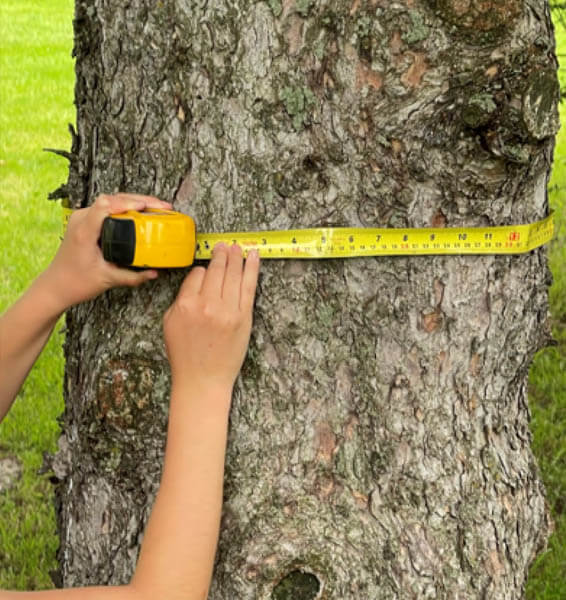In this activity, students observe the characteristics of trees in their community and think about why we should take care of them.
An important step in engaging students in eco-action is spending time experiencing nature. Trees have a key role in our eco-system. This activity gives children the chance to stop, observe the world around them and deepen their understanding about the interconnectedness of life on earth.

Grade level: K-3
Learning Objective(s):
– Compare different ways to measure trees
– Identify reasons trees should be taken care of
In this activity, students will:
– Observe and measure trees
– Reflect on why trees are important for the eco-system
Set up
Find a nearby wooded area, park or trees in the school yard. Select several trees (3 or 4) to measure based on predetermined criteria. Here are some suggestions:
- The biggest tree in the schoolyard
- Trees at a nearby wooded area or park
- Trees of varying sizes
- Trees of varying species
Collect different tools to measure trees. Here are some suggestions:
- Standard metric measuring tapes (soft)
- Masking tape and felt-tip markers for writing numbers
- Connecting links (e.g. chain links)
- Paper clips, connected together
- Rope/jump rope
Start it up
This is a chance for students to lead an investigation based on their predictions. Help students set up their experiments so they can make observations, for example, by putting pots with the same seed in different locations.
1: PICK/CREATE AN INVESTIGATION QUESTION:
- Do you think larger seeds take longer to sprout than smaller seeds?
- Do you think bigger seeds grow into taller plants?
- Does each pot need the same amount of soil, light, and water?
- Other (e.g. student-created question):
2: DATA COLLECTION
- Decide on a timeframe for your observation and a means of observation such as:
- Data-collection sheets
- Observation journals
- Drawings
3: SHARING RESULTS
After analyzing the results, create a way for the students to share their results. Some possibilities include:
- Sharing circles in small groups
- Science Posters
- Sharing with another class/buddies in the school
Results and discussion
Once the observation period has finished, return to the classroom. Have the students share their observations and compare their measurements.
Then, discuss the following questions:
About the activity:
- How did you measure how big the trees are? The circumference?
- Was it easier to measure the height or the width?
- How can we compare the size of trees?
- What do you think is the best way to measure the trees?
- What did you do if the measurement tool was not long enough to wrap around the tree trunk?
Going further:
- What do trees need to grow?
- Are bigger trees older than smaller trees?
- Why do you think some trees grow bigger than other trees?
- Which tree do you think is the most beautiful?
- Why are trees important for humans?
- Why should we take care of trees?
Next Step
Add community:
- Invite a local arborist to answer questions and to demonstrate some of the tools and resources they use in their everyday job. Ask them to point out any problems that trees might face in the schoolyard (e.g. the quality of the soil, the need for watering, mowers cutting too close to trees, etc.)
- Invite an Indigenous Elder to share traditional knowledge and practices (e.g. tapping maple trees for syrup)
Add wildlife:
Look for critters who live in and among trees.
Add excitement
- Find a tree game
- Learn How to Identify a Tree’s Age
- Arborist for an hour
Add an Earth Rangers Mission for Home
Mission: Just 1 Tree
References
- Trees of Canada (Tree Canada)
https://treecanada.ca/resources/trees-of-canada/ - Identify a Tree (Tree Bee)
https://treebee.ca/identify-a-tree/
